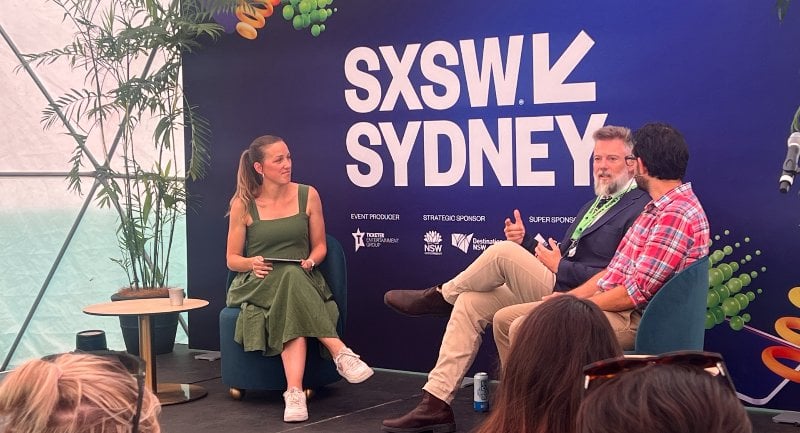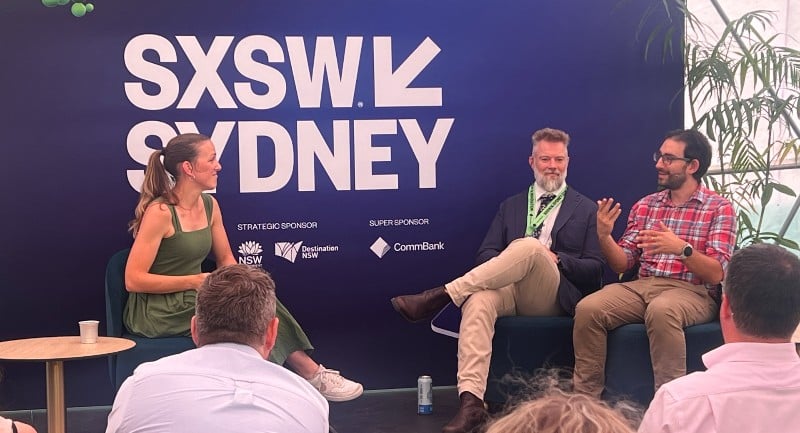What does it mean to exert influence? How do you do it effectively? These are common questions marketers and communications professionals ask themselves daily (hourly?) and while we all think we have a good handle on it as a concept, life always finds a way to interrupt the effectiveness of what works for us with alarming regularity.
In a SXSW session held yesterday by The Growth Distillery, a panel explored the idea of what influence is and how to best engage with it through a discussion branded as “Influence Disrupted: How the balance of influence has been upended and why that’s become our biggest superpower.”
Moderating the talk was Liza Williams, Head of Growth Intelligence at The Growth Distillery, who was joined by Everyday Massive Group CEO Toby Harrison and Dr Adrian Camilleri, an Associate Professor of Marketing at the University of Technology Sydney Business School and Director of the UTS Behavioural Lab.
After their panel talk, Mediaweek caught up with Liza Williams and Toby Harrison to discuss what communications and marketing professionals should be thinking about in regards to influence and creating affinity.
Mediaweek: Liza, what surprised or fascinated you most from today’s conversation?
Liza Williams: There’s some great examples out there of where people are using affinity. Most of all it was how potent that is as a measure, as an influencing factor, when we’re looking at decision making – I think was what really shocked me throughout the study and also while we were discussing it. Across all of the categories that we tested, it came out as number one.
We’ve looked at food, we’ve looked at finance, and even in the financial sector, affinity is still your most potent source of influence, which I think, for me, was quite shocking.
Mediaweek: What caught my interest was just this idea of wanting a connection with those seen as aspirational and part of that is seeking a connection with people on a human level (rather than people that we have no connection with). My big question is: Do people need to know more scientists in their lives?
Toby Harrison: [laughs] Maybe scientists just need to be a little bit more relatable and human.
I think that’s probably the big deal. When we think about the way that they’re turning up and presenting themselves to the world, I feel really dislocated and kind of not as proximate. I think everyone who’s got high affinity are close enough to our world, so yeah, maybe they just need to do a better job of being a bit more human.
Mediaweek: Through the panel conversation you discussed the idea that people look to their friend groups more than those with authority on topics. How can marketers disrupt those conversations, and maybe a better question: Should they?
Toby Harrison: We talked in our study about how 15-year-old girls in their bedrooms are more powerful now in the world of fashion than Anna Wintour is. What’s interesting about that is they are picking up on the work that marketers are doing, but just the work that the smart marketers are doing, the ones who are understanding their world and the way they inhabit it, and providing them with stuff that feels useful and fun and benevolent to them. That’s what’s creating value.
Marketers have a role to do this, but don’t do it the old way. Don’t bludgeon your way in. You’ve got to go in with something valuable, offer it, become a friend, be a good friend, be a useful friend, and then get out of the way.
Liza Williams: I agree. I think it’s much more now, it’s a two-way street, and brands have to give as well as they take. There’s a real opportunity to become part of those communities, give in a benevolent way, and really contribute to the community to be able to get that payback later on.

Mediaweek: During the panel conversation Toby, you spoke about a marketer charged with selling Pabst Blue Ribbon beer. They went and gave free beers to bike messengers because it was decided that they were among the most connected people in the community and could exhibit influence across their city.
What happens if the conversation goes in the opposite direction, where the influencers don’t like the product?
Toby Harrison: Unfortunately, that does happen sometimes. Also, you can pick people who are actually very detrimental for your brand as well. I’m not sure if everyone remembers it, but Burberry had billions wiped off their stock when Daniella Westbrook was draped head to toe in it.
There’s a very careful dance you have to do in selecting the audience that you want to provide value to. If you get it right, if you understand what your value proposition is, and you’re delivering it authentically and appropriately, people have the right to choose you or not choose you. But they’re more likely to choose you for the right reasons. If they don’t like you, you can’t win them over if your product doesn’t fit their needs.
No end of marketing can do that.
Liza Williams: That’s the key bit – having a product that fits their needs. First and foremost, it has to be a product that is going to serve what they want it to serve. If it doesn’t do that, then to your point, any amount of marketing in the world is not going to bring them over to your cause.
Mediaweek: A lot of the conversations that people have about influencers usually have that media broadcaster perspective, but I found it interesting that you spoke about influence strategy one-on-one. For those working in marketing and communications, what lessons can they take from their work with the public that they can bring back to their office for one-to-one influence?
Toby Harrison: I wouldn’t think ‘broadcast’ first. Influence is given to people, not denoted by a sense of authority. So if you want to have that ability to have a conversation with someone and be able to build affinity, you’ve got to essentially be in a tranche that they can access and they can come to you and they can have that engagement with you. So thinking about just going out and being broadcast sends completely the wrong signals, saying “I’m everything for everyone”, rather than “I’m actually here for you” and this is what I’m turning up for and this is what I’m providing for you and this is why we could probably be mates.
So that’s probably the big learning I would have out of this.
Liza Williams: I think you mentioned there about working and being in that workplace community. I think as well there’s a differing range across different age groups.
We’ve done a lot of work as well with Gen Z and we talked about it on the panel. People are much more heightened when you’re trying to influence them into a decision that they maybe don’t want to make. I think being aware of who your audience is, who you’re working with, who it is that you’re trying to have that impact on, that influence over, you can adjust some of your tone.
One of the things we didn’t talk about in the panel was the influence archetypes that underpin this piece of work as well. We can see that different types of decisions require different archetypes of influence, different voices, different approaches, and I think being much more aware of what your approach is for your audience is going to give you a much better payoff.

